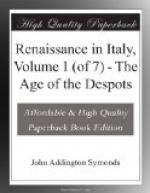When the struggle for existence has been successfully terminated, and the mere instinct of self-preservation no longer absorbs the activities of a people, then the three chief motive forces of civilization begin to operate. These are cupidity, or the desire of wealth and all that it procures; curiosity, or the desire to discover new facts about the world and man; and the love of beauty, which is the parent of all art. Commerce, philosophy, science, scholarship, sculpture, architecture, painting, music, poetry, are the products of these ruling impulses—everything in fact which gives a higher value to the life of man. Different nations have been swayed by these passions in different degrees. The artistic faculty, which owes its energy to the love of beauty, has been denied to some; the philosophic faculty, which starts with curiosity, to others; and some again have shown but little capacity for amassing wealth by industry or calculation. It is rare to find a whole nation possessed of all in an equal measure of perfection. Such, however, were the Florentines.[1] The mere sight of the city and her monuments would suffice to prove this. But we are not reduced to the necessity of divining what Florence was by the inspection of her churches, palaces, and pictures. That marvelous intelligence which was her pride, burned brightly in a long series of historians and annalists, who have handed down to us the biography of the city in volumes as remarkable for penetrative acumen as for definite delineation and dramatic interest. We possess picture-galleries of pages in which the great men of Florence live again and seem to breathe and move, epics of the commonwealth’s vicissitudes from her earliest commencement, detailed tragedies and highly finished episodes, studies of separate characters, and idylls detached from the main current of her story. The whole mass of this historical literature is instinct with the spirit of criticism and vital with experience. The writers have been either actors or spectators of the drama. Trained in the study of antiquity, as well as in the council-chambers of the republic and in the courts of foreign princes, they survey the matter of their histories from a lofty vantage ground, fortifying their speculative conclusions by




